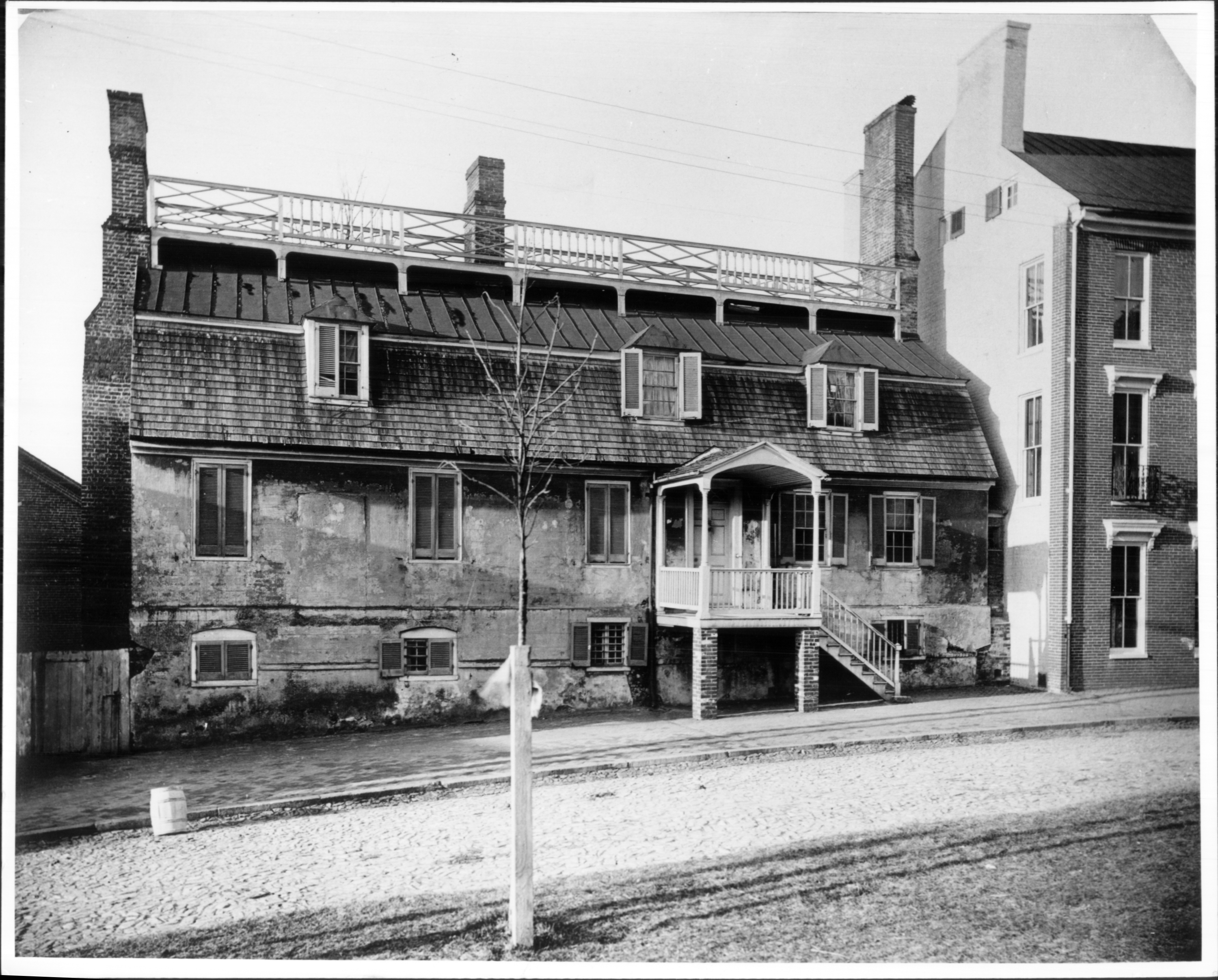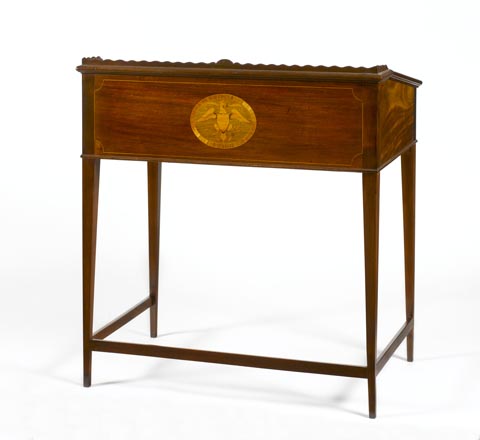

John Shaw
MSA SC 3520-13640
Cabinetmaker
Biography:
Born in Glasgow in April 1745, likely to John Shaw and Mary Cassels, many of the details of John Shaw's early life remain unknown.[1/2] While it has been previously thought that Shaw may have relocated to Annapolis, Maryland as early as 1763 when a John Shaw appeared in the St. Anne's vestry minutes, it has since been determined that the person referenced is actually Dr. John Shaw, a physician living in Annapolis around the same time. The earliest known record of John Shaw the cabinetmaker in Annapolis is in an April 1770 assault case against Thomas Sparrow, for which charges were dropped.[3]
In 1772, Shaw and fellow Scottish-born cabinetmaker Archibald Chisholm entered a profitable business partnership.[4] The pair completed a multitude of both public and private commissions - including several projects on behalf of the state and notable members of Annapolis society such as Edward Lloyd IV and James Brice. It is thought that Shaw made at least two trips back to Glasgow - one in 1772 and another in 1775, which may have influenced his neoclassical furniture style.[5] Apart from cabinetmaking, Shaw and Chisholm also imported luxury goods. After Shaw and Chisholm dissolved their partnership in November 1776, John Shaw continued his cabinetmaking business in the same shop until it burned down in 1783.[6] Chisholm and Shaw briefly resumed their partnership between 1783 and 1784 as a result of the fire in Shaw's shop.
In
1777 until 1819, Shaw also held the position as armorer for the State
of Maryland for which he was in charge of stocking arms and ammunition
for the use of the army, along with other odd jobs for the state
including supplying candles. When Congress held session in Annapolis in
1783-1784, making the city the first peacetime capital of the United
States, the state entrusted Shaw to craft a flag to fly over the
Maryland State House, potentially with the assistance of his seamstress
apprentice, Jane Lewis. Shaw was clearly well-respected by the
state and was entrusted with much of the preparations for the public dinner, ball, and
illumination of the State House in the celebrations surrounding George
Washington's resignation in the Old Senate Chamber of the State House
on December 23, 1783.[7]
Shortly after Washington's resignation, Shaw moved his shop to a property on State Circle. Once there, he could more easily complete commissions for politicians and the state. In December of that year, he teamed up with Archibald Chisholm once again to hang the portrait of Washington, Lafayette, & Tilghman at Yorktown in the Maryland State House. The task had been entrusted to them by the painting's artist, Charles Willson Peale, who had previously lived in Annapolis and worked alongside Shaw on prior occassions.[8/9]
Over the course of the next several decades, Shaw completed several projects on behalf of the state of Maryland. In the late 1780s, Shaw was paid for making and acquiring several pieces of furniture for the House of Delegates, including two tables, seats, and benches, and curtains.[10] In 1792, Shaw worked alongside William Gilmor as carpenters for the completion of the construction of the Maryland State House's roof and dome. When architect and overseer, Joseph Clarke, left the position in 1794, leaving the completion of the interior of the dome to Shaw.[11] Following the completion of the dome in 1797, Shaw had already set about completing another piece of major work for the State House. After assessing furniture in the building in need of repair, the Maryland General Assembly commissioned Shaw to make six arm chairs for the Executive Chambers and "24 Mahogany arm chairs, 10 Mahogany Desks for the use of the Senate & 1 neat Mahogany do. for the president."[12] The ten mahogany desks did not complete the full set of desks that would have been in the Old Senate Chamber prior to Shaw's additions, it is possible the desks were intend to replace only the desks that were beyond repair. The work included several other additions to the Old Senate Chamber, including the procurement of a carpet and blinds for the windows.[13]
When Shaw died in 1829, the Maryland Gazette marked his passing with a lengthy obituary, remarking that he was, "one of the oldest and most respectable inhabitants of this city....He was gifted by nature with strength, as well as fortitude of mind, and possessed a degree of self-control which rarely permitted the calmness of temper, for which he was remarkable, to be distrubed. Thus happily constituted, he pursued his way, content in the conscious rectitude of his heart, and the just aim of his actions. Not withstanding his earthly existence had been protracted, by Divine Providence, to a term beyond that allotted to most men, his whole conduct remained free from reproach, and he descended into the grave, survived by a fair and unblemished reputation, and in peace with the human family. He was not afraid to die! -A life characterised by industry, temperance, strict integrity, and punctual attention to religious duty, had stripped death of its terrors, and prepared him for that awful event. To conclude - he was a good man, who lived sincerely beloved by his family, and deservedly esteemed by his fellow-citizens; and has, we trust, passed from this world of care, to partake of the joys promised to the righteous."[16]
[1] Shaw Family Bible, MSA SC 1598.
[2] "Scotland, Births and Baptisms, 1564-1950," index, FamilySearch (https://familysearch.org/pal:/MM9.1.1/FM9Z-WH8: accessed 24 Sept 2013), Jno. Shaw, 22 Apr 1745.
[3] PROVINCIAL COURT (Judgement Record), 1770, MSA S551-85, vol. DD 17, f.430.
[4] The Maryland Gazette, 25 February 1773.
[5] Dobson, David, Original Scots Colonists of Early America, 1612-1783. Genealogical Publishing Co, 1989, p.299.
[6] The Maryland Gazette, 14 November 1776.
[7] Lu Bartlett, "John Shaw: Cabinetmaker of
Annapolis" in William Voss Elder III and Lu Bartlett, John Shaw: Cabinetmaker
of Annapolis (Baltimore: Baltimore Museum of Art, 1983), 13-26.
[8] Charles Willson Peale to Samuel Chase, 23 November 1784, The Selected Papers of Charles Willson Peale and His Family, vol. 1.
[9] Bartlett, p. 19.
[10] Proceedings of the Governor and Council, 1788-1791, Archives of Maryland Online, p.351.
[11] "History of the State House and its Dome," The Maryland State House, Maryland State Archives, 2007. Last accessed 9 July 2014: msa.maryland.gov/msa/mdstatehouse/html/story.html.
[12] Treasurer of the Western Shore (Journal of Accounts), 1797-1801, folio 48.
[13] Maryland State Papers (Scharf Papers), Box No. 80, Item No. 170.
[14] Governor and Council (Orders on the Treasury), 1807, MSA S1092-1, MdHR 1941.
[15] The Maryland Gazette, 5 March 1829.
[16] Ibid.
|
Tell Us What You Think About the Maryland State Archives Website!
|